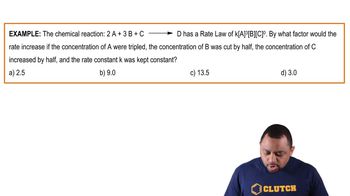Here are the essential concepts you must grasp in order to answer the question correctly.
Equilibrium Constant (Kc)
The equilibrium constant, Kc, is a numerical value that expresses the ratio of the concentrations of products to reactants at equilibrium for a given reaction at a specific temperature. It is calculated using the formula Kc = [B]^b / [A]^a, where [B] and [A] are the equilibrium concentrations of the products and reactants, respectively. A Kc value greater than 1 indicates that products are favored at equilibrium.
Recommended video:
Equilibrium Constant Expressions
Initial Concentration and Changes at Equilibrium
In chemical reactions, the initial concentration of reactants and products influences the equilibrium position. For the reaction aA(g) ⇌ bB(g), if the initial concentration of A is 1.0 M and no B is present, the change in concentration as the system reaches equilibrium must be calculated. This involves determining how much A is converted to B based on the stoichiometric coefficients a and b.
Recommended video:
Concentration Changes and Rate Law Example
Stoichiometry in Reactions
Stoichiometry refers to the quantitative relationship between reactants and products in a chemical reaction, defined by their coefficients in the balanced equation. In the context of the given reaction, the coefficients a and b indicate the molar ratios in which A and B react and are produced. Understanding stoichiometry is essential for calculating the changes in concentrations of A and B as the system reaches equilibrium.
Recommended video:




